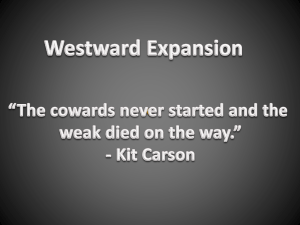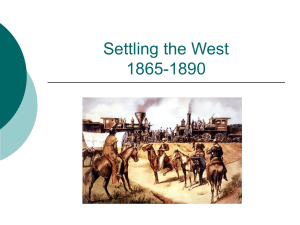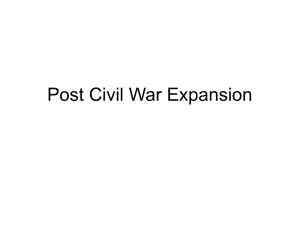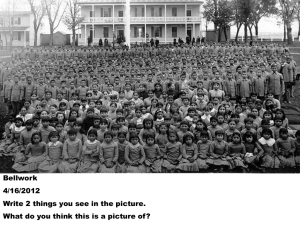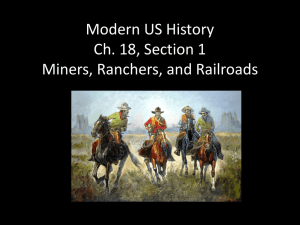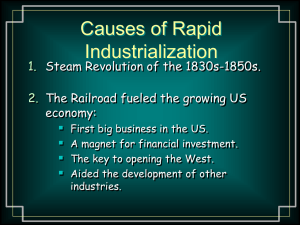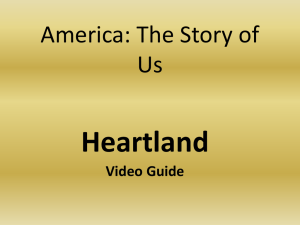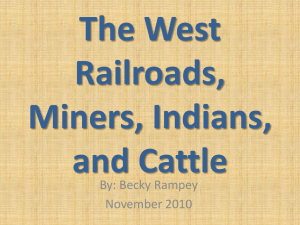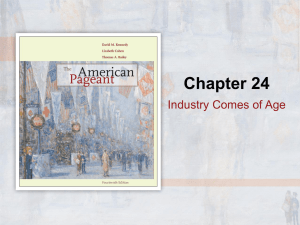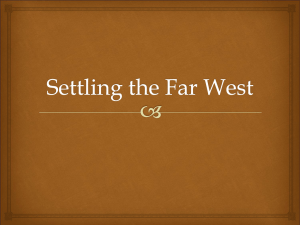Review!
advertisement
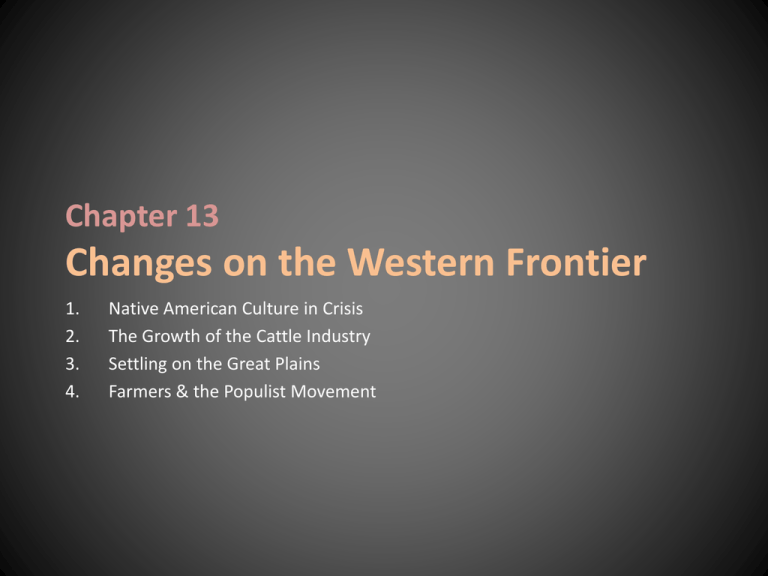
Chapter 13 Changes on the Western Frontier 1. 2. 3. 4. Native American Culture in Crisis The Growth of the Cattle Industry Settling on the Great Plains Farmers & the Populist Movement Native American Culture in Crisis “Between the 1850s & 1890, settlers flocked to the West in search of gold or land. In the process, they nearly destroyed the traditional culture of Native Americans living on the Great Plains. Competition for land often led to bloody conflict…” Teachers Note… They are NATIVE AMERICANS/NATIVES. They are NOT Indians. By everything holy on this earth and any other earth in our universe, if you call them “Indians” I will die on the inside. (And probably ((I will)) take points away.) For 250+ years we have KNOWN that they are not Indians, yet we still refer to them as such. First of many sports references in this chapter…. Pedro Cerrano & Wild Thing. Best ballplayers. Ever. These Are The Indians These Are Not… The Great Plains Colorado, Kansas, Montana, Nebraska, New Mexico, North Dakota Oklahoma, South Dakota, Texas, and Wyoming The Great Plains The State of America at the Time… “America was big, and the further you got into America the bigger it became, both landscapes and the natural wonders and artifacts.” Paul Johnson A History of the American People Why expand westward into the heart of America? Land. Agriculture. Railroads. Industry. Gold. The State of America at the Time… Population By Year By 1860, America & its people were growing faster than any country. Life expectancy grew & infant mortality dropped. 1865: 39,818,449 1880: 50 million + 1890: 62,847,714 (More than any European nation except Russia.) 1900: 75 million + 1914: 100 million + The State of America at the Time… Natural increase was aided by mass-immigration. 1815 to 1865: Over 5 million From Europe (50% English, 40% Irish). 1865 to 1890: Over 10 million From Great Britain, Germany, Scandinavia. 1890 to 1914: Over 15 million From Eastern & Southern Europe. From 1910 to 1914: Immigration average? One million per year. America was becoming overcrowded. Where are these people to go? West. Settlers Explore the Frontier Clash of culture ensued when settlers came in contact with Natives. – Settlers determined the land had been forfeited since Natives did nothing to improve it. Homestead Act of 1862 – Granted 160 acres of federal land, must be cultivated for five years. – 10% of the United States will be given away. Homestead Act of 1862 “Never in human history, before or since, has authority gone to such lengths to help the common people become landowners.” - Land was not suitable to familiar methods of farming. - Farmers dug into water tables & developed drought resistant strains of grain. Exodusters: African-Americans who moved from the South to Kansas following Reconstruction in a great “exodus”. Transcontinental Railroad 1862: Pacific Railroad Act is passed giving federal lands to Union Pacific and Central Pacific to construct the first transcontinental railroad. Union Pacific: Missouri River, through the Great Plains, to the Rocky Mountains Central Pacific: Sacramento through the Sierra Nevada Transcontinental Railroad Met at Promontory Summit, Utah, on May 10th, 1869 Transcontinental Railroad Transcontinental Railroad Central Pacific Railroad Company Union Pacific Railroad Company 3,000 Irish workers 10,000 Chinese workers Irish Civil War veterans Hundreds would die due to inclement weather, occupational hazards, or Native attacks. The human cost was extravagant: In 1889, the Interstate Commerce Commission shows that more than 22,000 workers were killed or injured. Both companies would lay as much track as possible to raise profits. Union Pacific had built 1,086 miles of track Central Pacific had built 689 miles of track Second sports reference in this chapter… Let’s keep count? We’re at 3! California Gold Rush of 1849 Colorado Gold Rush of 1861 Native Relations Nonintercourse Act of 1834: Set aside the Great Plains as one large reservation. Stated that no white person could enter Native country without a license. 1851: Due to excitement from the gold rush, Treaty of Fort Laramie is signed. Peace follows for a short while. In time this would bring a clash with settlers. Page 383 Is this Manifest Destiny being fulfilled, or people being denied their homelands? Are they brutes or simply the victims of a nation with great hopes? Plains Indian Wars (Native) Roughly from the 1860s – 1880s. “Uprisings” by hostile tribes of the Great Plains horse and buffalo cultures. Subdued by buffalo extermination and campaigns by the US military. Massacre at Sand Creek in 1864 The Cheyenne? Just Kidding. The Cheyenne & The Colorado Territory Militia Cheyenne Tribe Flag Col. John Chivington Massacre at Sand Creek 1864 - The Cheyenne raided trails off their reserve for supplies. - Colorado Gov. orders the militia to suppress the “raiders”. - Those who do not wish to fight were to report to a fort where they would be safe. - Colonel John Chivington led an attack on the fort, by order, in which he killed 70 – 200 Cheyenne. Most women & children. “I saw the bodies of those lying there cut all to pieces, worse mutilated than any I ever saw before; the women cut all to pieces ... With knives; scalped; their brains knocked out; children two or three months old; all ages lying there, from sucking infants up to warriors ... By whom were they mutilated? By the United States troops ...” John S. Smith, during a Congressional Testimony (1865) Fetterman Massacre on Bozeman Trail The Sioux were bothered by settlements established on the Bozeman Trail (Wyoming). When requests from the tribes went unanswered, the Sioux and other tribes began attacks. Cpt. William J. Fetterman and his company troops were ambushed and around 80 were killed. Aftermath of the Fetterman Massacre • Skirmishes continued (1866 – 1868) • Sioux (forced to) signed the Treaty of 1868 – Agreed to live along the Missouri River reservation in return for support from the govt. Excerpt from the Text Treaties rarely did much to stop the fighting or conflict between settlers & Natives. “[We] have been taught to hunt and live on the game. You tell us that we must learn to farm… and take on your ways. Suppose the people living beyond the great sea should come and tell you that you must stop farming… kill your cattle… what would you do? Would you not fight them?” Gall, a Sioux tribesman Pg. 384 Conflict with the Kiowa & Comanche In the Southern Plains, two tribes refused to move to reservations. Thus began a raiding spree (lasted 6yrs.) that would lead to the Red River War (1874-1875) To fight the resistance, the US Army often massacred tribesmen to crush moral and their will to fight. Strategy was to deny the Natives any safe haven through constant attack. This included wiping out buffalo. Custer & His Last Stand Causes – Gold Rush, Settlers, Culture Clash Result – Custer’s Last Stand After a Sioux victory at Rosebud Creek (Montana), their next challenge was Custer. Seeking fame & absolute victory, Custer rode against 2,000 – 3,000 Native warriors… With 200 men. The battle lasted less than half an hour. All US troops were killed. Aftermath – US citizens want revenge. Sitting Bull retreats to Canada. Dawes Act (1887) & Assimilation Dawes Act Assimilate Natives into American culture. How? Privatize land through property ownership by family rather than tribe. Any land left over would be sold to settlers. Educating Natives “We know that you highly esteem the kind of learning taught in those colleges, and that the maintenance of our young men, while with you, would be very expensive to you. We are convinced, therefore, that you mean to do us good by your proposal, and we thank you heartily. But you who are wise must know that different nations have different conceptions of things; and you will therefore not take it amiss if our ideas of this kind of education happen not to be the same with yours. We have had some experience of it: several of our young people were formerly brought up at the colleges of the northern provinces; they were instructed in all your sciences; but when they came back to us, they were bad runners; ignorant of every means of living in the woods; unable to bear either cold or hunger; knew neither how to build a cabin, take a deer, or kill an enemy; spoke our language imperfectly; were therefore neither fit for hunters, warriors, or counsellors; they were totally good for nothing. We are, however, not the less obliged by your kind offer, though we decline in accepting it: and to show our grateful sense of it, if the gentlemen of Virginia will send us a dozen of their sons, we will take great care of their education, instruct them in all we know, and make men of them." Wounded Knee: The Last “Battle” Sitting Bull was killed prior to in an incident: Seeking his arrest, a personal body guard fired and killed a policeman. The police open fired killing Sitting Bull. 7th Calvary 20 – 45 killed Sioux Tribes 300 – 400 killed (most women & children) Soldiers rounded up 350 Sioux and brought them to Wounded Knee Creek. A shot was fired by accident leading the military to open fire on the camp. Most in the camp were unarmed. Chapter 13 Section 1 REVIEW! Review! Describe the Great Plains. What are some states it covers? What is the land like? The “heart” of America. Stretches from Texas to Montana. Review! What are the five reasons for exploring and settling past the Mississippi? Hint (L.I.A.R. G) Land Industry Agriculture Railroads Gold Review! What was the main contributing factor that truly forced America to settle the Great Plains? Growth in population, immigration. Review! What was the Homestead Act of 1862? Gave 160 acres to anyone who could cultivate the land for five years. Largest land giveaway in the history of the world. 10% of the US would be given away. Review! What were “exodusters”? African-Americans who left the PostReconstruction south for Kanas in a mass “exodus”. Review! Describe the Transcontinental Railroad. What were the two companies that were hired to complete the task? Where did the two rails meet? Union & Central Pacific. Met in Promontory Summit, UT. Review! Describe the kind of workers that Union Pacific and Central Pacific hired to complete the work. Mostly Chinese & Irish. Many Civil War veterans were also hired. Review! What were the two treaties signed before the Civil War in regards to Native American relations? Nonintercourse Act of 1834 & Treaty of Fort Laramie (1851) Review! What were some of the main events in the Plains Indian Wars? Massacre at Sand Creek, Fetterman Massacre, Treaty of 1868, Custer’s Last Stand, Dawes Act, Massacre at Wounded Knee Review! What was the Dawes Act? What is assimilation? Dawes Act privatized Native reservations in an attempt to destroy Native culture. Assimilation is the adopting and adapting to of a culture that is different. The Growth of the Cattle Industry & Settling on the Great Plains Chapter 13 Sections 2 & 3 The Growth of the Cattle Industry “As settlers took over the Native American lands, they developed a thriving cattle industry. Learning skills and borrowing… from Mexicans, cowboy herded cattle and shipped them by railroad to growing cities in the east. The cowboy became one of America’s most romantic figures. By the 1880s… droughts, blizzards, and the introduction of barbed wire ended the cattle frontier.” Growth of the Cattle Industry Population By Year By 1860, America & its people were growing faster than any country. Life expectancy grew & infant mortality dropped. 1865: 39,818,449 1880: 50 million + 1890: 62,847,714 (More than any European nation except Russia.) 1900: 75 million + 1914: 100 million + Sports reference… #4. Growth of the Cattle Industry The Texas Longhorn Characterized by their horns (up to 8ft!) Not native to the United States, they were introduced by Spanish settlers in the 1500s. Before railroads, it was hunted and used primarily for hits hide. After railroads were built, the Longhorn became noted for its dairy and beef. The Transcontinental Railroad, Beef, and YOU! As settlers took Native Lands, they began to… settle… Farming Ranching Herding The Cowboy Known as the “Vaquero” in Mexico, the Cowboy was vital to the growth of the cattle industry. Before the railroad: Cattle were slaughtered for their hides After the railroad: Cattle could be transported to cities where food was in demand. Air conditioned cars. Air Conditioned Train Car The Boston Daily Advertiser (April 1869) "A refrigerator car... arrived in this city yesterday morning laden with 16,000 pounds of beef placed on board at Detroit on Wednesday of last week. This car was in charge of Mr. George H. Hammond on its passage. The ice is placed in narrow chambers at each side of the car, opening only at the top from outside, and does not, therefore, come in contact with the meat or the air in the car which is kept cold and dry. The meat was in better condition than that received directly from our home markets.” The Cowboy Cattle Dealer, Joseph McCoy desired to create a shipping yard where the trail would meet the rail. Abilene, Kansas, would become that city. From Abilene, cattle could be transported anywhere. Thus, the Chisholm Trail was born & ran from San Antonio to Abilene. Lol. #5. Go Giants. The Cowboy Lol x 2. 1 in 4 were African-American. 1 in 10 were Mexican. Often leading herds ranging from 1,000 to 4,000 or more, the Cowboy had a tough job. Come 1887, lasting just over 20 years, the Cowboy would see its end due to barbed wire and bad weather. Spring – Round up. Starve them, brand them, herd them. The Long Drive. Could last 3 months or more. City dwellers glorified the Cowboy for their life of “adventure”. Sleeping outdoors, riding horses, confronting Natives (not as frequent as one may believe.). Cities and Towns Prosper • Tacoma, Reno, Fresno, Cheyenne, Billings, Albuquerque all grew from the Railroad. • Chicago, St. Louis, Omaha, Sioux City all became major meat-packing centers. Number 6… could’ve been 7 with the Dallas Mavericks… Settlers & Farmers By 1865, there were 20,000 pioneers who had migrated westward. By 1905, 500,000 more would become Homesteaders. However, over two million families would buy land from railroad companies, the government, or through other means. Settlers & Farmers 1884 – Five Transcontinental Railroads Settlers & Farmers • Farmers in the Great Plains experienced a variation of different hardships: • Floods, fires, droughts, blizzards, locusts, and the threat of Native Americans. The weather was the biggest threat. #7 Thunder & lightning posed a large threat to both cowboys & settlers -> – Farmers lived in “soddies”. – Women had better opportunity in the Great Plains: • Ratio of men to women was about 100 to 1. • Women worked side by side with men and often owned land or businesses. Settlers & Farmers Inventions by John Deere (Steel Plow in 1837) and Cyrus McCormick (Reaping Machine in 1847), seed drills and barbed wire, made work easier. However, it would cast many farmers into debt. Morrill Land Grant Act of 1862 #8 Passed to help support agricultural education by granting federal lands to states to form agricultural colleges. The Hatch Act of 1887 built agricultural research stations to make farming Improvements such as threads of grain that were able to survive in droughts. EXTRA POINT What is the designated “land grant” university of New Jersey? Hint Chapter 13 Section 2 REVIEW! Review! What were some of the main reasons for the growth of the cattle industry in the USA? Growing population, transcontinental railroad. Review! What was the name of the cattle that we focused on? Where did it come from? Why was it used? The Texas Longhorn. Brought from Spain in 1500s. Very lean meat, good quality. Review! What impact did the Transcontinental Railroad have on settlers and Natives? The railroad removed Natives from their land opening it up to settlers to farm, herd, or ranch. Review! Before the railroad, what were cattle primarily used for? What inventions helped to move cattle across the country? Killed for hides. The railroad, the Chisholm Trail, and air conditioned cars helped move cattle. Review! Who had the idea to make trail meet rail with the Chisholm Trail? Where did it start and meet? Joseph McCoy. The trail started in San Antonio, Texas and met the rail at Abilene, Kansas. Review! Describe the duties of a cowboy. What kind of diversity did cowboys have? Corralling, herding, branding, etc… 1 in 4 = African-American 1 in 10 = Mexican Review! Name some of the cities that grew from the railroad & the cattle drive. Tacoma, Reno, Fresno, Cheyenne, Billings, Albuquerque all grew from the Railroad. Chicago, St. Louis, Omaha, Sioux City all became major meat-packing centers. Review! By 1884, how many Transcontinental Railroads were there? Five. Review! What were the threats that farmers & settlers experienced on the frontier? Floods, fires, droughts, blizzards, locusts, and the threat of Native Americans. Review! What were living conditions like on the Frontier? How were women treated? No wood = living in soddies. Women were often treated better than in cities and on coasts. Review! What did the Morrill Act of 1862 do? The Hatch Act of 1887? Morrill Act = Land Grant Colleges (A&M) Hatch Act = Built agricultural research stations BONUS REVIEW. Name all sports teams I used as references from both lessons & note their significance: 1. 2. 3. 4. 5. 6. 7. 8. Natives & Pedro Cerrano. Gold Diggers. Gold Diggers. MOOOOOO. Worst football team. Ever. Derrick Rose/Windy City. Kevin “Durantula” Durant. Johnny Football. 1. 2. 3. 4. 5. 6. 7. Cleveland Indians San Francisco 49ers Denver Nuggets Texas Longhorns Dallas Cowgirls Chicago Bulls Oklahoma City Thunder 8. Texas A&M
